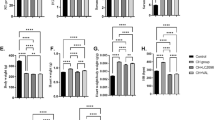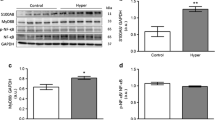Abstract
Elevated thyroid hormone (TH) levels induce cardiac hypertrophy partially via type 1 Angiotensin II receptor (AT1R). MicroRNAs (miRNAs) are key regulators of cardiac homeostasis, and miR-133 has been shown to be involved in cardiac hypertrophy. However, the potential role of miR-133 in cardiac growth induced by TH is unknown. Thus, we aimed to investigate the miR-133 expression, as well as its potential role in cardiac hypertrophy in response to TH. Wistar rats were subjected to hyperthyroidism combined or not with the AT1R blocker. T3 serum levels were assessed to confirm the hyperthyroid status. TH induced cardiac hypertrophy, as evidenced by higher cardiac weight/tibia length ratio and α-actin mRNA levels, which was prevented by AT1R blocker. miR-133 expression was decreased in TH-induced cardiac hypertrophy in part through the AT1R. Additionally, the cardiac mRNA levels of miR-133 targets, SERCA2a and calcineurin were increased in hyperthyroidism partially via AT1R, as evaluated by real-time RT-PCR. Interestingly, miR-133 levels were unchanged in T3-induced cardiomyocyte hypertrophy in vitro. However, a gain-of-function study revealed that miR-133 mimic blunted the T3-induced cardiomyocyte hypertrophy in vitro. Together, our data indicate that miR-133 expression is reduced in TH-induced cardiac hypertrophy partially by the AT1R and that miR-133 mimic prevents the cardiomyocyte hypertrophy in response to T3 in vitro. These findings provide new insights regarding the mechanisms involved in the cardiac growth mediated by TH, suggesting that miR-133 plays a key role in TH-induced cardiomyocyte hypertrophy.




Similar content being viewed by others
References
Abdellatif M (2010) The role of microR-133 in cardiac hypertrophy uncovered. Circ Res 106:16–18. doi:10.1161/CIRCRESAHA.109.212183
Arai M, Otsu K, MacLennan DH, Alpert NR, Periasamy M (1991) Effect of thyroid hormone on the expression of mRNA encoding sarcoplasmic reticulum proteins. Circ Res 69:266–276. doi:10.1161/01.RES.69.2.266
Barreto-Chaves ML, Heimann A, Krieger JE (2000) Stimulatory effect of dexamethasone on angiotensin-converting enzyme in neonatal rat cardiac myocytes. Braz J Med Biol Res 33:661–664. doi:10.1590/S0100-879X2000000600007
Biondi B, Kahaly GJ (2010) Cardiovascular involvement in patients with different causes of hyperthyroidism. Nat Rev Endocrinol 6:431–443. doi:10.1038/nrendo.2010.105
Biondi B (2012) Mechanisms in endocrinology: heart failure and thyroid dysfunction. Eur J Endocrinol 167:609–618. doi:10.1530/EJE-12-0627
Carè A, Catalucci D, Felicetti F, Bonci D, Addario A, Gallo P, Bang ML, Segnalini P, Gu Y, Dalton ND, Elia L, Latronico MV, Høydal M, Autore C, Russo MA, Dorn GW 2nd, Ellingsen O, Ruiz-Lozano P, Peterson KL, Croce CM, Peschle C, Condorelli G (2007) MicroRNA-133 controls cardiac hypertrophy. Nat Med 13:613–618. doi:10.1038/nm1582
Carneiro-Ramos MS, Diniz GP, Nadu AP, Almeida J, Vieira RL, Santos RA, Barreto-Chaves ML (2010) Blockage of angiotensin II type 2 receptor prevents thyroxine-mediated cardiac hypertrophy by blocking Akt activation. Basic Res Cardiol 105:325–335. doi:10.1007/s00395-010-0089-0
Castoldi G, Di Gioia CR, Bombardi C, Catalucci D, Corradi B, Gualazzi MG, Leopizzi M, Mancini M, Zerbini G, Condorelli G, Stella A (2012) MiR-133a regulates collagen 1A1: potential role of miR-133a in myocardial fibrosis in angiotensin II-dependent hypertension. J Cell Physiol 227:850–856. doi:10.1002/jcp.22939
Chang KC, Figueredo VM, Schreur JH, Kariya K, Weiner MW, Simpson PC, Camacho SA (1997) Thyroid hormone improves function and Ca2+ handling in pressure overload hypertrophy. Association with increased sarcoplasmic reticulum Ca2+-ATPase and alpha-myosin heavy chain in rat hearts. J Clin Invest 100:1742–1749. doi:10.1172/JCI119699
Dillmann W (2010) Cardiac hypertrophy and thyroid hormone signaling. Heart Fail Rev 15:125–132. doi:10.1007/s10741-008-9125-7
Diniz GP, Carneiro-Ramos MS, Barreto-Chaves ML (2009) Angiotensin type 1 receptor mediates thyroid hormone-induced cardiomyocyte hypertrophy through the Akt/GSK-3beta/mTOR signaling pathway. Basic Res Cardiol 104:653–667. doi:10.1007/s00395-009-0043-1
Diniz GP, Takano AP, Bruneto E, Silva FG, Nunes MT, Barreto-Chaves ML (2012) New insight into the mechanisms associated with the rapid effect of T3 on AT1R expression. J Mol Endocrinol 49:11–20. doi:10.1530/JME-11-0141
Diniz GP, Takano AP, Barreto-Chaves ML (2013) MiRNA-208a and miRNA-208b are triggered in thyroid hormone-induced cardiac hypertrophy—role of type 1 Angiotensin II receptor (AT1R) on miRNA-208a/α-MHC modulation. Mol Cell Endocrinol 374:117–124. doi:10.1016/j.mce.2013.04.010
Dong D, Duan Y, Guo J, Roach DE, Swirp SL, Wang L, Lees-Miller JP, Sheldon RS, Molkentin JD, Duff HJ (2003) Overexpression of calcineurin in mouse causes sudden cardiac death associated with decreased density of K+ channels. Cardiovasc Res 57:320–332. doi:10.1016/S0008-6363(02)00661-2
Dong DL, Chen C, Huo R, Wang N, Li Z, Tu YJ, Hu JT, Chu X, Huang W, Yang BF (2010) Reciprocal repression between microRNA-133 and calcineurin regulates cardiac hypertrophy: a novel mechanism for progressive cardiac hypertrophy. Hypertension 55:946–952. doi:10.1161/HYPERTENSIONAHA.109.139519
Dorn GW 2nd (2010) Therapeutic potential of microRNAs in heart failure. Curr Cardiol Rep 12:209–215. doi:10.1007/s11886-010-0096-7
Duisters RF, Tijsen AJ, Schroen B, Leenders JJ, Lentink V, van der Made I, Herias V, van Leeuwen RE, Schellings MW, Barenbrug P, Maessen JG, Heymans S, Pinto YM, Creemers EE (2009) miR-133 and miR-30 regulate connective tissue growth factor: implications for a role of microRNAs in myocardial matrix remodeling. Circ Res 104:170–178. doi:10.1161/CIRCRESAHA.108.182535 (6p following 178)
Ferreira JC, Moreira JB, Campos JC, Pereira MG, Mattos KC, Coelho MA, Brum PC (2011) Angiotensin receptor blockade improves the net balance of cardiac Ca(2+) handling-related proteins in sympathetic hyperactivity-induced heart failure. Life Sci 88:578–585. doi:10.1016/j.lfs.2011.01.009
Ganesan J, Ramanujam D, Sassi Y, Ahles A, Jentzsch C, Werfel S, Leierseder S, Loyer X, Giacca M, Zentilin L, Thum T, Laggerbauer B, Engelhardt S (2013) MiR-378 controls cardiac hypertrophy by combined repression of mitogen-activated protein kinase pathway factors. Circulation 127:2097–2106. doi:10.1161/CIRCULATIONAHA.112.000882
Hu LW, Benvenuti LA, Liberti EA, Carneiro-Ramos MS, Barreto-Chaves ML (2003) Thyroxine-induced cardiac hypertrophy: influence of adrenergic nervous system versus renin-angiotensin system on myocyte remodeling. Am J Physiol Regul Integr Comp Physiol 285:R1473–R1480. doi:10.1152/ajpregu.00269.2003
Huang MB, Xu H, Xie SJ, Zhou H, Qu LH (2011) Insulin-like growth factor-1 receptor is regulated by microRNA-133 during skeletal myogenesis. PLoS One 6:e29173. doi:10.1371/journal.pone.0029173
Huang ZP, Chen J, Seok HY, Zhang Z, Kataoka M, Hu X, Wang DZ (2013) MicroRNA-22 regulates cardiac hypertrophy and remodeling in response to stress. Circ Res 112:1234–1243. doi:10.1161/CIRCRESAHA.112.300682
Kenessey A, Ojamaa K (2006) Thyroid hormone stimulates protein synthesis in the cardiomyocyte by activating the Akt-mTOR and p70S6K pathways. J Biol Chem 281:20666–20672. doi:10.1074/jbc.M512671200
Klein I, Danzi S (2007) Thyroid disease and the heart. Circulation 116:1725–1735. doi:10.1161/CIRCULATIONAHA.106.678326
Kobori H, Ichihara A, Miyashita Y, Hayashi M, Saruta T (1999) Local renin-angiotensin system contributes to hyperthyroidism-induced cardiac hypertrophy. J Endocrinol 160:43–47. doi:10.1677/joe.0.1600043
Kuzman JA, O’Connell TD, Gerdes AM (2007) Rapamycin prevents thyroid hormone-induced cardiac hypertrophy. Endocrinology 148:3477–3484. doi:10.1210/en.2007-0099
Liang F, Webb P, Marimuthu A, Zhang S, Gardner DG (2003) Triiodothyronine increases brain natriuretic peptide (BNP) gene transcription and amplifies endothelin-dependent BNP gene transcription and hypertrophy in neonatal rat ventricular myocytes. J Biol Chem 278:15073–15083. doi:10.1074/jbc.M207593200
Luo X, Lin H, Pan Z, Xiao J, Zhang Y, Lu Y, Yang B, Wang Z (2008) Down-regulation of miR-1/miR-133 contributes to re-expression of pacemaker channel genes HCN2 and HCN4 in hypertrophic heart. J Biol Chem 283:20045–20052. doi:10.1074/jbc.M801035200
Matkovich SJ, Wang W, Tu Y, Eschenbacher WH, Dorn LE, Condorelli G, Diwan A, Nerbonne JM, Dorn GW 2nd (2010) MicroRNA-133a protects against myocardial fibrosis and modulates electrical repolarization without affecting hypertrophy in pressure-overloaded adult hearts. Circ Res 106:166–175. doi:10.1161/CIRCRESAHA.109.202176
Molkentin JD, Lu JR, Antos CL, Markham B, Richardson J, Robbins J, Grant SR, Olson EN (1998) A calcineurin-dependent transcriptional pathway for cardiac hypertrophy. Cell 93:215–228. doi:10.1016/S0092-8674(00)81573-1
Montgomery RL, Hullinger TG, Semus HM, Dickinson BA, Seto AG, Lynch JM, Stack C, Latimer PA, Olson EN, van Rooij E (2011) Therapeutic inhibition of miR-208a improves cardiac function and survival during heart failure. Circulation 124:1537–1547. doi:10.1161/CIRCULATIONAHA.111.030932
Nagai R, Zarain-Herzberg A, Brandl CJ, Fujii J, Tada M, MacLennan DH, Alpert NR, Periasamy M (1989) Regulation of myocardial Ca2+-ATPase and phospholamban mRNA expression in response to pressure overload and thyroid hormone. Proc Natl Acad Sci USA 86:2966–2970. doi:10.1073/pnas.86.8.2966
Pantos C, Paizis I, Mourouzis I, Moraitis P, Tzeis S, Karamanoli E, Mourouzis C, Karageorgiou H, Cokkinos DV (2005) Blockade of angiotensin II type 1 receptor diminishes cardiac hypertrophy, but does not abolish thyroxin-induced preconditioning. Horm Metab Res 37:500–504. doi:10.1055/s-2005-870317
Papait R, Greco C, Kunderfranco P, Latronico MV, Condorelli G (2013) Epigenetics: a new mechanism of regulation of heart failure? Basic Res Cardiol 108:361. doi:10.1007/s00395-013-0361-1
Periasamy M, Bhupathy P, Babu GJ (2008) Regulation of sarcoplasmic reticulum Ca2+ ATPase pump expression and its relevance to cardiac muscle physiology and pathology. Cardiovasc Res 77:265–273. doi:10.1093/cvr/cvm056
Soci UP, Fernandes T, Hashimoto NY, Mota GF, Amadeu MA, Rosa KT, Irigoyen MC, Phillips MI, Oliveira EM (2011) MicroRNAs 29 are involved in the improvement of ventricular compliance promoted by aerobic exercise training in rats. Physiol Genomics 43:665–673. doi:10.1152/physiolgenomics.00145.2010
Triggiani V, Iacoviello M (2013) Thyroid disorders in chronic heart failure: from prognostic set-up to therapeutic management. Endocr Metab Immune Disord Drug Targets 13:22–37. doi:10.2174/1871530311313010005#sthash.EqpF9lWp.dpuf
Thum T, Catalucci D, Bauersachs J (2008) MicroRNAs: novel regulators in cardiac development and disease. Cardiovasc Res 79:562–570. doi:10.1093/cvr/cvn137
Ucar A, Gupta SK, Fiedler J, Erikci E, Kardasinski M, Batkai S, Dangwal S, Kumarswamy R, Bang C, Holzmann A, Remke J, Caprio M, Jentzsch C, Engelhardt S, Geisendorf S, Glas C, Hofmann TG, Nessling M, Richter K, Schiffer M, Carrier L, Napp LC, Bauersachs J, Chowdhury K, Thum T (2012) The miRNA-212/132 family regulates both cardiac hypertrophy and cardiomyocyte autophagy. Nat Commun 3:1078. doi:10.1038/ncomms2090
van Rooij E, Sutherland LB, Liu N, Williams AH, McAnally J, Gerard RD, Richardson JA, Olson EN (2006) A signature pattern of stress-responsive microRNAs that can evoke cardiac hypertrophy and heart failure. Proc Natl Acad Sci USA 103:18255–18260. doi:10.1073/pnas.0608791103
Villar AV, Merino D, Wenner M, Llano M, Cobo M, Montalvo C, García R, Martín-Durán R, Hurlé JM, Hurlé MA, Nistal JF (2011) Myocardial gene expression of microRNA-133a and myosin heavy and light chains, in conjunction with clinical parameters, predict regression of left ventricular hypertrophy after valve replacement in patients with aortic stenosis. Heart 97:1132–1137. doi:10.1136/hrt.2010.220418
Wang J, Song Y, Zhang Y, Xiao H, Sun Q, Hou N, Guo S, Wang Y, Fan K, Zhan D, Zha L, Cao Y, Li Z, Cheng X, Zhang Y, Yang X (2012) Cardiomyocyte overexpression of miR-27b induces cardiac hypertrophy and dysfunction in mice. Cell Res 22:516–527. doi:10.1038/cr.2011.132
Acknowledgments
This work was supported by Fundação de Amparo à Pesquisa do Estado de São Paulo (FAPESP, Foundation for the Support of Research in the State of São Paulo, Process number: 2009/14567-7) and by CNPq (National Council of Technological and Scientific Development).
Author information
Authors and Affiliations
Corresponding author
Ethics declarations
On behalf of all authors, the corresponding author states that there is no conflict of interest.
Rights and permissions
About this article
Cite this article
Diniz, G.P., Lino, C.A., Guedes, E.C. et al. Cardiac microRNA-133 is down-regulated in thyroid hormone-mediated cardiac hypertrophy partially via Type 1 Angiotensin II receptor. Basic Res Cardiol 110, 49 (2015). https://doi.org/10.1007/s00395-015-0504-7
Received:
Revised:
Accepted:
Published:
DOI: https://doi.org/10.1007/s00395-015-0504-7




